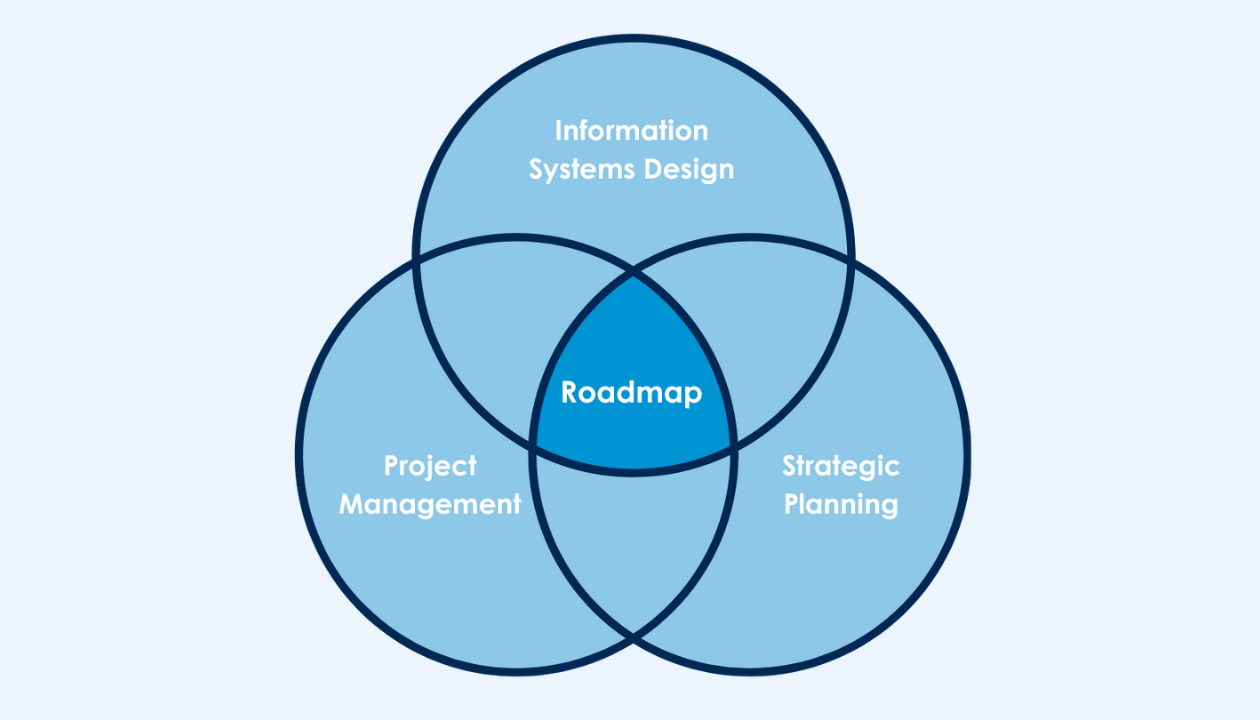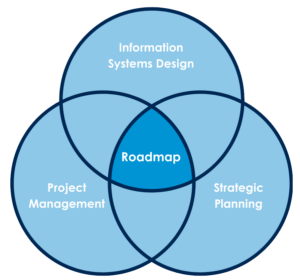Why Your Organization Needs a Technology Roadmap

Liz Murray
Vice President, Professional Services
Making plans can be exciting and fun but also can be stressful and a lot of work, especially when coordinating plans across an organization! In this blog, I aim to help take some of the anxiety out of planning by sharing insights into how to build a thoughtful technology roadmap designed to nurture and align your data ecosystem. I’ll also share tips on how you and your colleagues can work together to create a vision that truly propels your organization forward.
What is a Technology Roadmap?
The term “technology roadmap” can mean different things to different people. For us, a roadmap sits at the cross-section of three knowledge areas.

- Information Systems Design: The roadmap process helps you understand your current state and design a future state for your systems based on your strategic vision.
- Project Management: The roadmap helps you divide your backlog into individual projects, manage benefit delivery, and plan ahead. This is a game changer in terms of resource allocation.
- Strategic Planning: This is an exercise that requires leadership buy-in and vision – the roadmap should drive strategy across your entire organization
Why Do You Need a Roadmap?
A clear technology roadmap helps to ensure that your organization’s technology investments align with your business priorities.
A roadmap will:
- Drive Digital Transformation: As a nonprofit, it can be overwhelming to think about all the things you need to do to integrate digital technology into your business. It’s hard to know where to start and how to sort out the dependencies within your data ecosystem. A roadmap prioritizes and organizes the work, and articulates how exactly you will get from point A to point B.
- Optimize Resource Allocation: Resource allocation is a complex challenge for nonprofits. A roadmap can provide clarity, efficiency, and transparency. By clearly articulating your organization-wide technology priorities, you can align teams to ensure everyone is working towards the same goals and plan ahead to secure funding and appropriately staff your projects.
- Manage Project Portfolios: One of the key features of a roadmap is articulating what you are NOT working on. This will reduce noise and allow you to focus better. By establishing your priorities for the next 2-3 years, you give yourself the time to invest in project management best practices.
- Maximize Impact: A roadmap will provide prioritization to allow you to plan with purpose! As part of the process, you must scrutinize your work log to determine what is truly worth the effort and to identify which initiatives should be done first. This will help you maximize impact as you will focus on the items with the greatest value.
- Manage Change Effectively: Change is hard but necessary for growth. As part of the roadmap process, you will engage stakeholders, create a shared vision, and develop a clear plan of attack. With a roadmap in hand, your organization can get ahead of change management.
- Improve Efficiency: By looking at your organization-wide needs, you can streamline processes, break down silos, and reduce redundancies. Analyzing key dependencies within your ecosystem as well as the big picture will allow you to be thoughtful and deliberate in your approach.
Building a technology roadmap is an ongoing journey, not a destination. It requires consistent effort, open communication, and a willingness to adapt. I encourage you to embrace the collaborative process, involve key stakeholders across your organization, and prioritize continuous improvement.
Pop Quiz
Let’s have some fun with some true or false questions.
Question 1: IT is solely responsible for creating a roadmap for the organization.
Answer: False
While IT plays a big role, creating an effective roadmap is a highly collaborative process.
- IT must work closely with subject matter experts from each functional area to truly understand business needs and with managers and leadership to plan projects realistically.
- They must work closely with managers and leadership to plan the projects—to truly understand what is possible in terms of budget and staff time to create a realistic timeline
- They must communicate openly and work proactively to align staff expectations so that everyone is working from the same playbook.
Question 2: A roadmap is a living document that should be revisited at least annually.
Answer: True
Set it and forget it, if only! Inevitably even the best laid plans change. For example:
- You experience staff turnover or need to accommodate unexpected leaves.
- You learn something big from a project in year one that results in rethinking some of your former assumptions.
- You implement a new CRM which helps identify new priorities.
- You have new leadership who wants to switch gears.
I recommend not only revisiting the roadmap but having a retrospective with your colleagues to talk about what went well and what didn’t go so well so you can learn from your past experiences. This will foster a culture of continuous improvement and growth mindsets.
Question 3: Your roadmap should include everything you plan to do in the next 5-10 years.
Answer: False
As a planner, I would love to be able to do this. In reality, we don’t have a crystal ball and can’t predict the future.
We have found that planning 2-3 years out is ideal. This practice goes hand and hand with treating the roadmap as a living document. You are going to learn from your roadmap and need to leave room to iterate.
If you’re feeling overwhelmed or unsure where to begin, let us know. We can help you scope your roadmap, identify key priorities, and develop a plan that aligns with your unique needs and goals.
